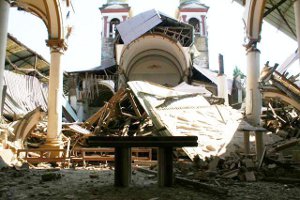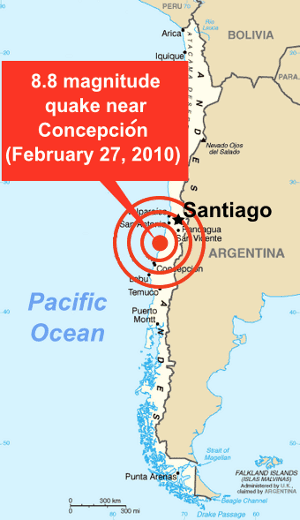Chile, the land of earthquakes
 This earthquake, one of the most powerful in a century claimed the lives of 452 people, left 800 000 homeless and caused damages ranging between 15 and 30 billion USD, that is, 10% of the country's GDP.
This earthquake, one of the most powerful in a century claimed the lives of 452 people, left 800 000 homeless and caused damages ranging between 15 and 30 billion USD, that is, 10% of the country's GDP.
For insurance, the bill would amount to sums between 4 and 7 billion USD, according to Munich Re and Swiss Re's estimates, and between 2 and 8 billion USD according to the modeling company AIR. Chile's earthquake could, therefore, stand as the second most costly in the recent thirty years following the one that devastated Northridge, California in 1994 and which caused losses of 15.3 billion USD.
The February 27, 2010 earthquake was:
- the seventh most powerful earthquake ever reported
- the world's fifth most violent earthquake for a century
- Chile's second most important earthquake after the one of 1960
Apart from material and human losses, this earthquake, which was followed by tens of aftershocks, resulted in the geographic alteration of the region with the displacement of some South-American cities westwards (Concepción has moved by 3.04 meters, Santiago, the capital city by 27.7 centimeters). Some scientists have even suggested that a drastic change affected planet earth with a deviation of the Earth's rotation axis by 8 centimeters.
The Chilean coasts: a long history of earthquakes
 Located on a subduction zone with the convergence of the two major tectonic plates: the Pacific plate and the South American plate, Chile which counts almost 16 million inhabitants, is situated on one of the most seismic regions on earth.
Located on a subduction zone with the convergence of the two major tectonic plates: the Pacific plate and the South American plate, Chile which counts almost 16 million inhabitants, is situated on one of the most seismic regions on earth.
As a consequence, Chile is regularly hit by high-intensity earthquakes (more than 8 degrees of magnitude), followed in most cases by devastating tsunamis.
Statistics reveal that each year Chile sustains 500 small tremors, seven of which are significant, and every 30 years it faces a destructive earthquake. On May 22, 1960, the Southern part of the country was devastated by the most violent earthquake in the history of seismology. With a 9.5-degree magnitude, this earthquake associated to a tsunami cost the lives of 1655 people and resulted in numerous modifications of the coastal region.
The most powerful earthquakes reported worldwide for a century
| Date | Country | Magnitude | Number of victims |
|---|---|---|---|
1960 | Chile | 9.5 | 1655 |
1964 | Alaska | 9.2 | 128 |
2004 | Indonesia - Sumatra | 9.1 | 222 000 |
1952 | Russia - Kamchatka | 9 | 0 |
2010 | Chile | 8.8 | 452 |